TLDR:
- Parents are more inclined to increase childcare usage due to “experience-led improvements” rather than just price reductions. This indicates a shift in focus from cost savings to overall service quality and integration into family life. Factors such as flexible pricing and a strong curriculum play a significant role in encouraging higher attendance.
- Top reasons for increased attendance include flexible pricing options that adapt to varied family needs. Additionally, a robust curriculum that clearly demonstrates a child’s developmental progress is highly valued by parents. These elements contribute to a perception of genuine educational value and convenience.
- A significant 80% of parents are willing to pay more for add-on services that simplify their daily routines and enhance convenience. This highlights a strong market for providers who offer solutions beyond basic childcare. These services demonstrate a deep understanding of the challenges faced by modern families.
- Over half of surveyed families are open to switching childcare providers if they can find a better overall experience. This indicates that loyalty is not guaranteed and providers must continually innovate to retain families. Parents are actively seeking environments that best support their child’s development and their own family needs.
- Loyalty to a childcare provider is strongly driven by the perception of a child’s progress and the feeling that parental feedback is valued. Clear communication and capable staff are also crucial in building and maintaining trust. Providers who prioritize these aspects are more likely to foster long-term relationships with families.
It’s 7:42 AM on a Tuesday. One child refuses to eat breakfast. Another can’t find their shoes. A parent juggles a packed lunch, a work call, and a mental checklist that never seems to shrink. In this chaos, the childcare centre is the only thing holding the day together.
This is what modern families are navigating across Australia, and it’s why the idea of “premium childcare” is evolving. It’s about practicality that centres that don’t just care for children, but help life run more smoothly.
And families are ready to invest in that.
The Childcare Customer Opportunities ANZ 2025 report by Resonate CX provides a clear view of what families consider worth the extra cost. Based on survey data from hundreds of parents across early learning and outside-of-school-hours care (OSHC) services, the report identifies the key features, service gaps, and value drivers that shape enrolment and loyalty today.
This article explores what defines a premium childcare experience in the eyes of Australian families and what childcare AU providers can do to stay ahead of these rising expectations.
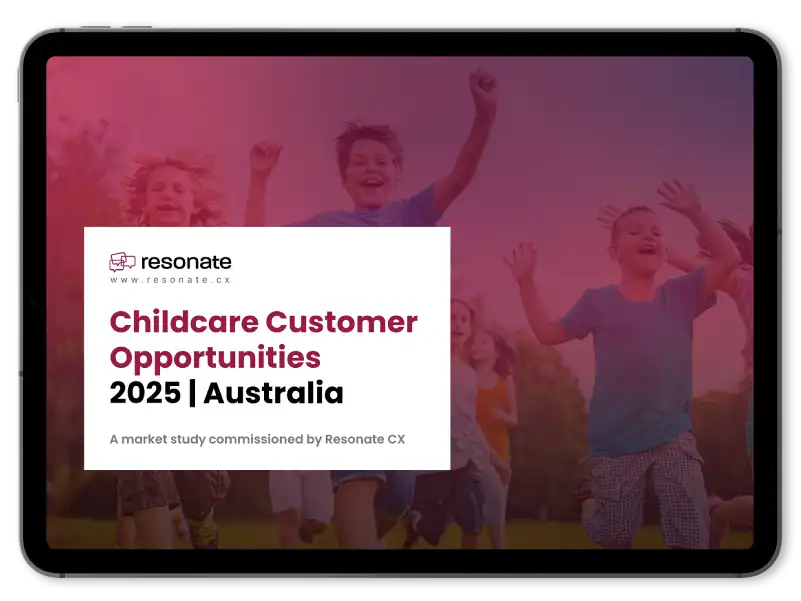
CHILDCARE Customer Opportunities 2025 | AUSTRALIA
Uncover what parents value most when choosing childcare providers.
1. What Encourages Parents to Increase Childcare Usage?
You might assume discounts drive enrolment increases. But families are telling a different story.
They’re far more responsive to experience-led improvements than price cuts. Things like better communication, visible developmental progress, and flexible hours matter more than a one-off deal. It’s the feeling that the centre is in sync with their life.
For instance, extended pick-up hours (without extra fees) go a long way for working parents. The ability to adjust attendance plans based on their week creates a sense of control. And having confident, qualified educators builds trust, which directly influences attendance and loyalty.
It’s simple: when families feel supported, they stick around and show up more often.
In summary, these are the top reasons families consider increasing attendance:
- More flexible pricing options
Variable attendance plans or tailored packages help families feel more in control of their spending. - Stronger curriculum offerings
Parents want a clear balance of play and learning, with visible developmental progress and regular updates. - Extended pick-up hours at no extra cost
Busy households appreciate the extra buffer without added fees, particularly those with full-time working parents. - More qualified or experienced educators
Staff capability directly influences trust, and trust influences enrolment decisions.
Some motivations differ between early learning and OSHC users, but the trend is consistent: families are looking for value they can feel day to day. When the offering is well-communicated and backed by quality, increasing usage feels like a sensible decision rather than an indulgent one.
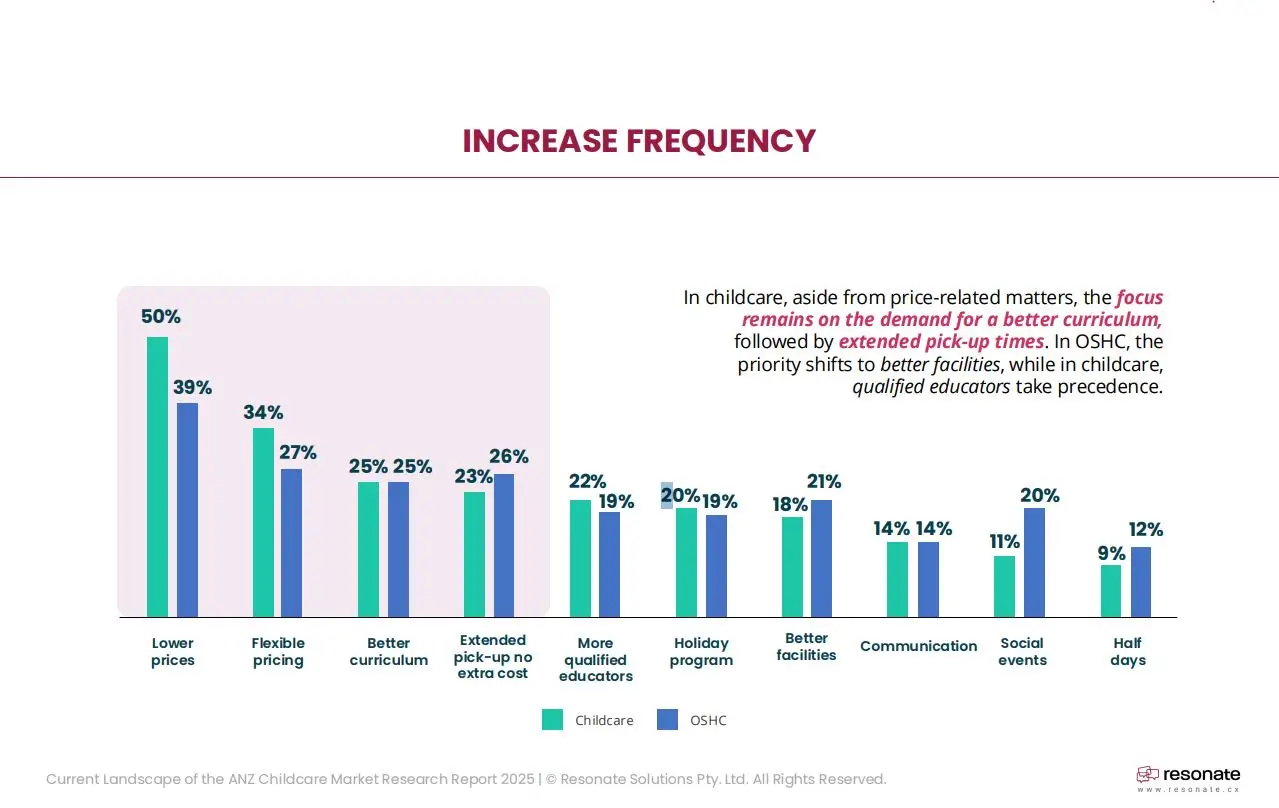
2. The Add-On Services That Make All the Difference
Convenience is a growing priority for Australian families, and many are willing to pay extra for features that support their everyday routines. In fact, Resonate CX’s research shows that 80% of parents are open to paying for additional childcare services, a clear signal that well-targeted extras can enhance both perceived value and family satisfaction.
Here are the add-on services parents are most willing to pay for:
- Fresh ready-made dinners
Simplifies the evening routine, especially for working parents trying to get dinner on the table quickly for their children. - In-house café or bakery, and grocery click-and-collect partnerships
Makes childcare centres feel like a one-stop hub for busy families managing multiple errands. - Morning pick-up and afternoon drop-off services
Helps ease the pressure during peak commute hours and supports flexible work schedules. - Soundproof work booths with Wi-Fi
Supports remote or hybrid workers needing a quiet space to take calls or finish tasks on-site. - Laundry or dry-cleaning services
Reduces the invisible load many parents carry and makes their day feel just a little more manageable.
These features don’t just meet practical needs; they signal a provider’s understanding of modern family life. Importantly, they also align with what younger parents increasingly expect, services that don’t just care for the child, but also support the entire household’s rhythm.
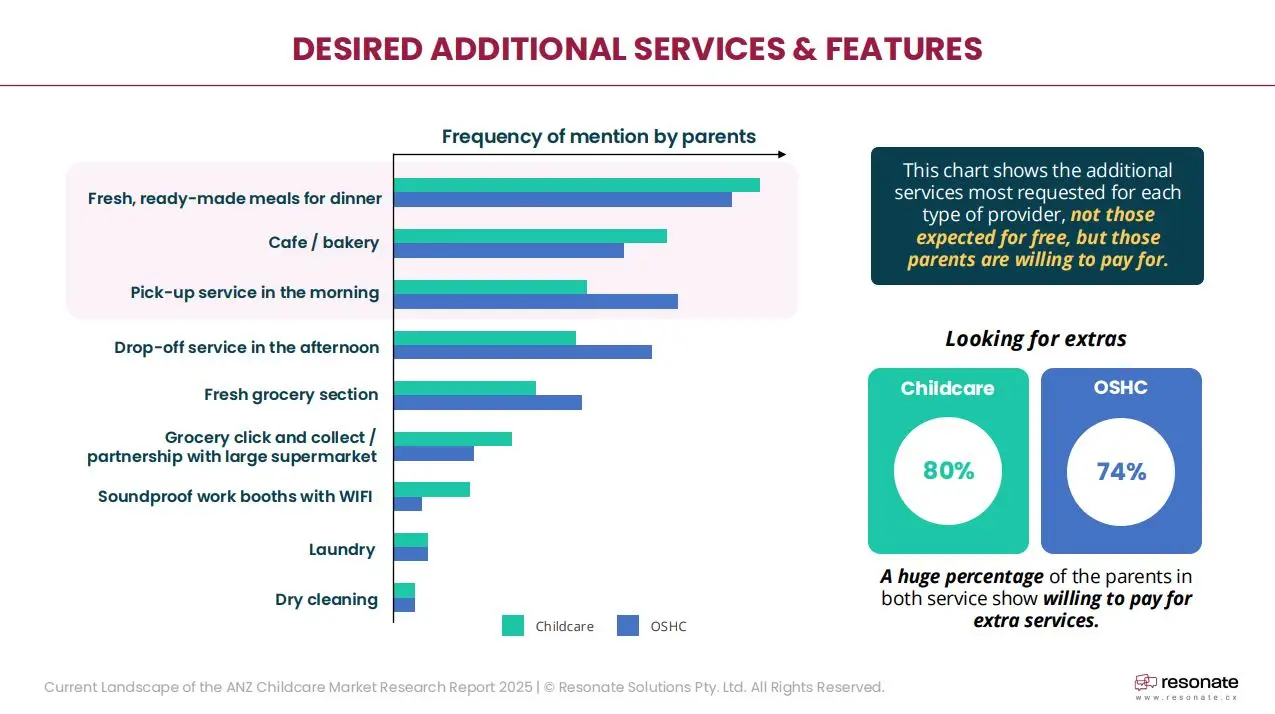
3. Willingness to Switch: How Added Features Influence Churn Risk
Over half of the families Resonate CX surveyed said they would consider switching providers if another offered a better experience.
Interestingly, those most likely to switch tend to be the most engaged: parents who are deeply involved in their child’s development, who expect clear communication and capable staff. If a service doesn’t meet their expectations, they’re not afraid to leave.
What keeps them loyal isn’t perfection but progress. It’s knowing their feedback matters, and seeing their child thrive in a space that evolves with them.
Segment-level insights help explain where these pressures are strongest:
- Partners are the most demanding and have the highest expectations across quality, communication, and staff capability. Many are willing to switch providers for a better experience, which makes them both highly valuable and high risk.
- Balancers are open to change if the offer is affordable and clearly supports work-life integration. Features like flexible pricing and reliable service hours resonate strongly.
- Explorers, while generally less demanding, are still open to switching to a provider that better meets their needs, particularly around flexibility and cost.
The data confirms a key principle: families tend to leave because they believe something better is available, not because of one single issue. Providers that anticipate and act on emerging expectations are best positioned to hold onto families long after the enrolment form is signed.
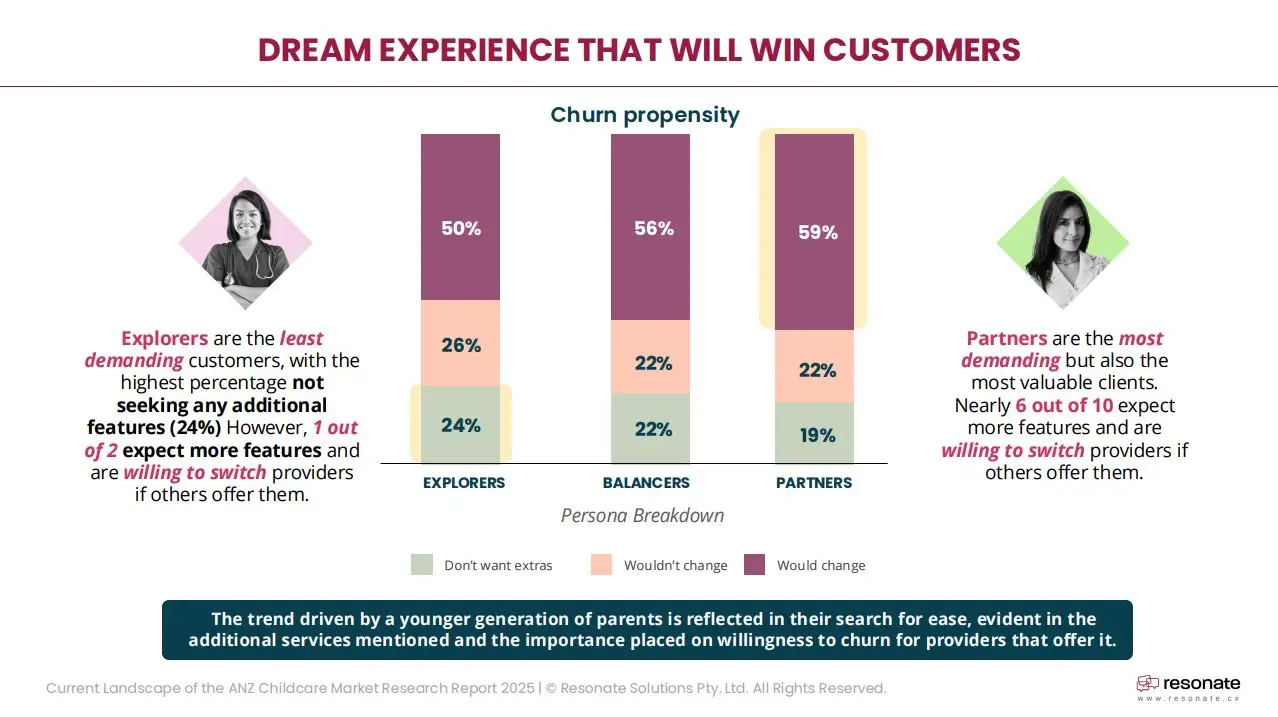
4. Willingness to Pay More: How Much of a Premium Can Childcare Services Charge?
The data is clear: 77% of families are willing to pay more, at least 5% extra, for a better childcare experience. A quarter would even pay up to 20% more.
But here’s the catch: they have to feel the difference.
For some, that means stronger developmental programs. For others, it’s the confidence of knowing a reliable educator is there every morning. For many, it’s simply being able to leave pick-up without rushing straight to the grocery store or panicking over dinner.
So let’s break it down, as in previous sections, willingness to pay varies by segment:
- Partners are the most prepared to invest in high-quality care, particularly if it includes strong developmental programming and consistent communication.
- Balancers are open to paying more when providers can match price increases with convenience and reliable service.
- Explorers are less inclined to pay premiums, but even they respond positively to low-cost, high-impact improvements like flexible schedules or better pick-up logistics.
The message is clear: families will pay more if the experience improves. What matters is transparency and trust; parents need to see that premium pricing reflects real, day-to-day value.
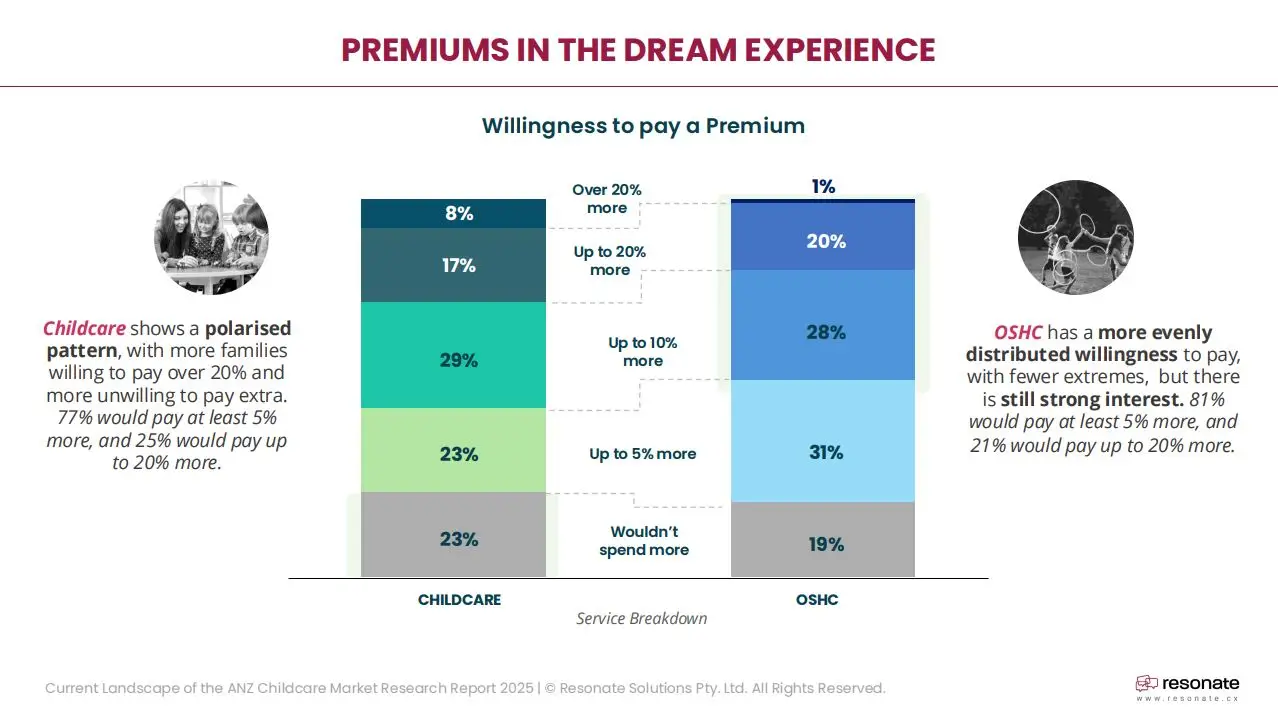
5. What Features Offer the Best ROI in a Premium Childcare Offering?
Not all “extras” carry the same weight.
Through our Dream Experience matrix, we found that certain features deliver both high interest and high impact. These include:
- Fresh meals and healthy food options
High on both desirability and influence, especially among full-day care users. - Transport options (pick-up and drop-off)
Provides tangible convenience and supports flexible schedules, which many parents prioritise. - Extended hours with no extra charge
Eliminates a common friction point while reinforcing value. - On-site Wi-Fi work booths
Still a niche request, but increasingly valued among hybrid workers managing flexible office hours.
These features serve a dual function: they improve family experience while differentiating the provider. For centres looking to grow through retention rather than constant acquisition, focusing on these high-ROI features is a smart, sustainable strategy.
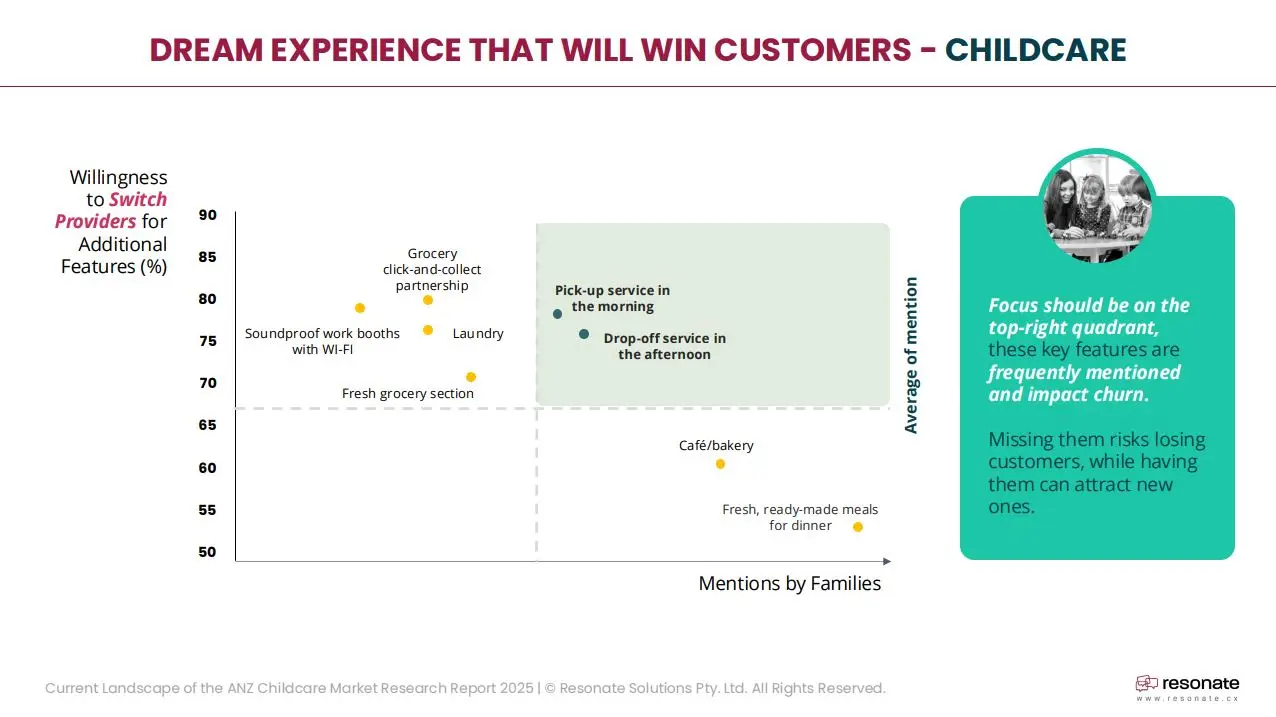
Conclusion: Unlocking the True Value of Premium Childcare
Childcare today isn’t just about caring for children. It’s about supporting the entire rhythm of family life.
Australian parents are ready to pay more, but only when the experience is better. Not louder. Not flashier. Just better.
So the question isn’t, “How can we charge more?” It’s: “How can we make every day feel just a little easier for the families we serve?”
Because when you help families breathe easier, they stay longer. And that’s the kind of loyalty no price tag can buy.










